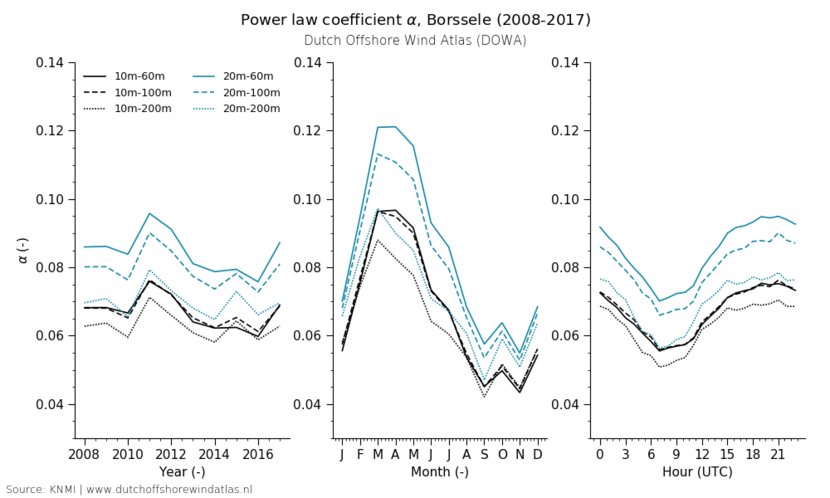Power law coefficient per wind farm zone and Cabauw
Power law coefficient α: yearly averages and 10-year monthly and diurnal averages.
The value of power law coefficient α is derived from the DOWA wind speeds: 10-60, 10-100, 10-200, 20-60, 20-100 and 20-200 m.
The figure below shows that:
- The values for α derived from the vertical wind speed gradients between 10-60 m and 10-100 m are almost identical (derived 10-200 m slightly lower). The values of α are more “sensitive” when 20 m is used as the lowest level: α derived from the vertical wind speed gradient between 20-200m is comparable to the one based on the gradient between 10-100 m, but α is significantly higher when derived from the gradient between 20-60 or 20-100m. As the values of α are less “sensitive” when 10 m is used as the lowest level, we have decided to present these values on the website: α derived from the vertical wind speed gradients between 10-100 m (10-60 almost identical) and 10-200m.
- (based on vertical wind speed gradient between 10-100 m) At Borssele wind farm the value for α derived from DOWA wind speeds varies from 0.04 in autumn to 0.10 in spring. The seasonal cycle is larger than the daily cycle (0.05-0.08), because the stability of the atmosphere (and therefore the vertical wind gradient and the value of α) is determined mainly by the sea surface temperature. In the spring the sea surface temperature is low compared to the air temperature above. This implies a stable atmosphere, a strong vertical wind gradient and a high value for α. In the autumn it is the other way around: the sea is warmer than the air above, the atmosphere more unstable, the vertical gradient in de wind and the value for α smaller. On land stability (and therefore the value of α) varies more during the day: the earth surface cools at night (atmosphere more stable) and heats during the day (more unstable).

The value of power law coefficient α is much higher at Cabauw than at Borssele. This is true for all land locations compared to sea locations and a result of:
- The higher surface roughness on land, which results in a stronger vertical wind speed gradient.
- The fact that the atmosphere is on average slightly more stable on land than at sea. This also implies a stronger vertical wind speed gradient.
Also the diurnal cycle at Cabauw is much more pronounced than at Borssele (0.15-0.35 instead of 0.05-0.08). So, on average the atmospheric stability on land varies more during 24 hours than it does at sea over the seasons. The value of α based on 20 m winds is higher than based on 10 m winds, which is the same for Borssele. Using linear regression does not seem to make much difference.
